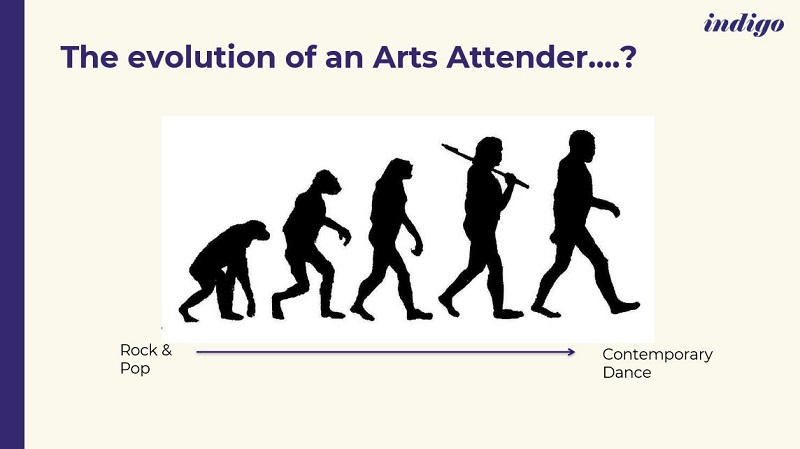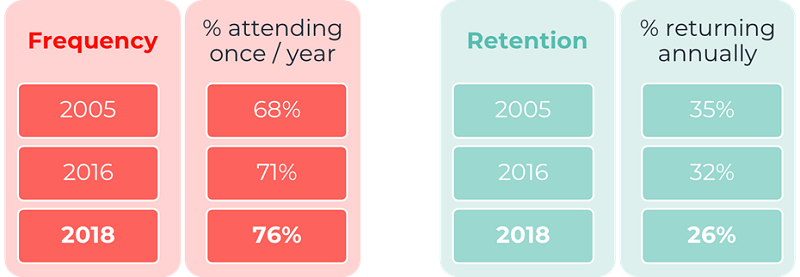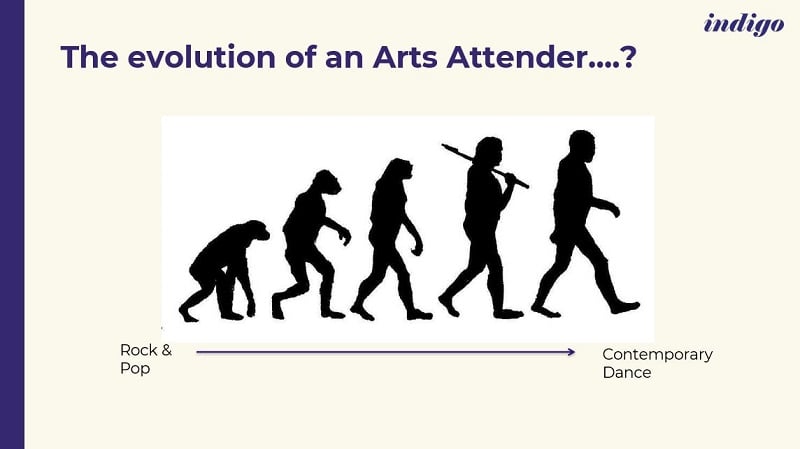4 min read
Inflation, Epidemics and Audience Loyalty: Arts Marketing in 2023

Traditional 'loyal attenders' aren't returning post-Covid. How do we redefine what loyalty means in the face of today's social challenges?
Katy Raines, Founder and CEO of Indigo Ltd, considers what the future of loyalty might look like for cultural organisations and their audiences. In this blog, she reflects on what we mean when we talk about loyalty, what, if anything has changed, and what that all means for the future.
This content was first presented in February 2023 as part of The Future of Audience Loyalty, a panel event hosted by Spektrix. If you missed out, we've now published the full event online - helping you to explore what customer loyalty means for theatres, cultural venues and touring organisations in the post-pandemic world.
What do we mean by audience loyalty in the arts?
A typical ‘loyal’ attender?
If you ask any arts marketer who’s been around for a while to describe what a typical ‘loyal attender’ is, they’d probably paint a picture of a person aged over 65, who attends ‘classic’ work such as Shakespeare, Opera, Ballet or Classical Music, is fairly predictable in their behaviour (they probably plan and book in advance), and is likely to be highly ‘culturally literate’ – attending a range of cultural organisations, as well as being a member or donor of at least one or two.
But of course we know from our work on audiences during Covid that these are the very people who have NOT come back to theatres and venues in anywhere near the numbers, or anywhere near the frequency they were doing so before Covid, and have stated that they plan to attend LESS frequently in the future, not more.
Loyalty metrics
So let’s think about the metrics or numbers typically used to define loyalty: usually a combination of frequency (how often someone attends), retention / churn (whether they continue to attend) and recency (how recently they’ve attended).
The thing is, both frequency and retention have been declining for quite a long time now . The figures below show that we have had an increasing proportion of the audience each year only attending once , and hanging on to fewer of our audiences from one year to the next. This hasn’t happened just since Covid – it’s been on its way for 15 years.
So, on this basis I would argue that the conversation around loyalty doesn’t start with how we refine or launch subscriptions for people coming 5, 8 or 10 times per year, but how we move some of THESE low-frequency people from attending once, to 2 or 3 times per year, ensuring that, at the very least, they’re coming back the following year.

Sources:
2005, ‘The Leaky Bucket’, Katy Raines; 2016, Spektrix Benchmark report 2017; 2018 Spektrix Insights report 2019
Taking risk
A common way in which arts marketers talk about more ‘engaged’ audiences is the people who can be encouraged to try ‘more challenging’ work. We’ve been encouraged to ‘develop’ an audience member, who may be introduced to us via ‘safe’ work, such as panto, or rock and pop, so that they become fully engaged, and are willing to attend new writing or contemporary dance.
To me this is just daft. This doesn’t demonstrate loyalty, as people will attend things that appeal to them, which are likely to be similar and based on their cultural tastes and preferences. So if we only have loyalty schemes that are designed to encourage our definition of ‘risk taking’ we’re going to lose out on a whole bunch of audiences who’d like to do something else.

How do social changes affect arts marketing and audience loyalty?
I believe there are four influencing factors from the past three years that may also affect how we view loyalty:
- Covid: Apart from the need to turn our attention to younger audiences to replace the older ‘missing audiences’, we also now have audiences who have learned to keep their options open in case things change: we’ve seen a rise in things such as last minute bookings and ticket protection insurance – to limit risk around attending events. So flexibility is key.
- Cost of Living: The very people (young people) we now need to attract more of, are exactly the people hardest hit financially by Covid, and now by the cost of living crisis. So for these people even attending once per year may be demonstrating considerable loyalty – prioritising spend with you over other choices when finances are tight.
- Value-driven purchasing: These young people are also more values-driven than their older relatives, particularly around the environment. Our Act Green research showed that cultural audiences are unclear where we as a sector stand on the environment – but that young people are prepared to get involved as activists and donors for issues around climate and culture, in a way they haven’t around culture alone.
- Relevance: Black Lives Matter and the Levelling Up agenda in the UK have created an imperative for cultural organisations to be more genuinely inclusive. But how does the whiff of elitism that is given off by a Members’ lounge, a fixed seat subscription or a Friends scheme, fit with the values of a younger, more diverse, activist generation who are more awake to inequalities afforded by wealth, power and privilege?
So all of this begs the question for me: how can we reward loyalty to our cause and our values in ways that matter more to, and are valued more by a younger generation?
The Future of Loyalty: 2023 and beyond...
So, given all of that, what does the future look like?
I believe that the future of audience loyalty in the arts:
- Starts at the bottom – trying to shift some of the swathes of once-a-year attenders into coming just once or twice more
- Offers the flexibility sought by audiences post-Covid
- Is values-driven and inclusive
- Rewards behaviour that aligns with our cause or values, perhaps around, but not limited to, environmental sustainability
- And therefore measures more than just frequency.
This content was first presented in February 2023 as part of The Future of Audience Loyalty, a panel event hosted by Spektrix. View the full recording and slides below.
THE FUTURE OF AUDIENCE LOYALTY
Katy Raines is the Founder and CEO of Indigo Ltd.
In 2022, Indigo Ltd worked with 58 organisations on the first Act Green survey, creating a benchmark of cultural audience attitudes towards sustainability.


